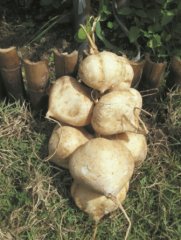Jicama ( Mexican Yam Seeds )
Jicama prefers full sun and a fair amount of space. It can be planted out once hardened off and the threat of frost has long passed. If the soil is rich with organic matter and is light and friable, you may only need up to 4 months for smaller roots to mature, which are equally as tasty as the larger ones. Pinch out the growth tips if the plants are getting too big and to encourage bushy, dense growth. Do not let the plants go to seed; pinch out the flowers for added root production.
Jicama is a day-length sensitive plant, which means that the tubers are not produced until the days toward the end of the growing season are fewer than 9 hours long. These shorter days often coincide with the first frosts of fall, so you may need to provide protection to get tubers of a usable size. Greenhouses work; so do cloches and portable cold frames, which protect the foliage from the threat of frost while heating up the micro-environment around the plant itself, thus extending the season somewhat. Jicama can also be grown indoors under a light set-up. You will only be able to grow one or two plants, but it's definitely worth the effort. Cloches can also be used at the beginning of the season to hasten the process in the early stages and to acclimate the young plants to the outdoors.
The plants will require support at some stage, if you want to keep them off of the ground. You can train jicama on a net, wire fence or bamboo tri-pod, but remember that if it is raised off of the ground, it might be impossible to protect it from frost.
Similar to potatoes, any parts of jicama growing above soil level are toxic. Avoid eating any parts that were growing above soil level. If you see any parts of the tubers being exposed to the sun, hill with soil.
Harvesting Jicama: Dig the tubers once the foliage has died away, likely from frost, as late in the season as possible to allow time for the tubers to develop. Once harvested, store the roots in a cool, dark location to prevent them from getting woody and tough.
Jicama can be added to the vegetable garden or to large containers once it is large enough, but its ornamental value is limited.
If you have a short, cool growing season, jicama can also be grown under polyethylene tunnels. These will heat up the environment surrounding the plants, while keeping pests at bay.

Shaped like a turnip, it has a thin brown skin and crisp, juicy flesh similar to a fine apple. Its soft flavor enables jicama to be used in a variety of ways. Although jicama can be used in some of the same ways as a potato, it is less starchy and lower in calories (a cup of sliced jicama has about 50 calories). The vegetable is a good source of vitamin C, and also contains some potassium, iron, and calcium.
Jicama, yam bean, Mexican potato, or Mexican turnip has been eaten in Central America for many centuries, and is now a common commodity in U.S. stores. The crop is cultivated in frost-free climates, grown in rows from seeds, and within a year this vine is harvested for its large taproot. But you can grow this in colder zones by starting seeds inside early and transplanting outside after last frost, harvesting roots in as little as four months after transplanting outside. To eat jicama, only the fibrous brownish peel must be removed.
Found on the web: Over 50 Jicama recipes.

